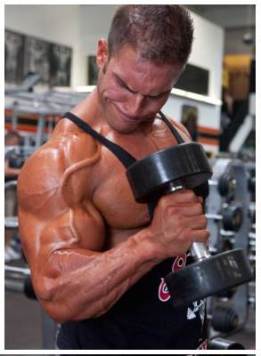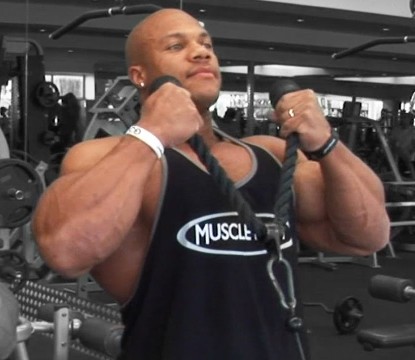Most bodybuilders concentrate on building bigger biceps at some point. The typical biceps exercise consists of a few movements such as the dumbbell biceps curl, barbell biceps curl, scott biceps curl and so on. The hammer curls, on the other hand, are not so common in the arm training routines. What most people don’t realize is that they are extremely effective and relatively easy to perform. This is why today we are exclusively focusing on how to use hammer curls to build bigger arms.
What is hammer curl?
This is an auxiliary arm workout that mainly develops the forearm (Brachioradialis) and brachii (bicep). Unlike with the standard dumbbell curl, you are required to maintain your thumbs facing inwards you and your wrists locked at all times. Besides working your biceps, hammer curls give your traps, anterior shoulders, brachioradialis, and brachialis a great deal of hard work.
The brachioradialis is the longer muscle that runs from the center of the forearm to the center of the upper arm. Although most workouts mainly focus on the biceps, diverting some attention to these two muscles is an important step towards creating impressively shaped big arms. Harmer curls give you a different way of working your biceps and forearms since they offer increased tension.
To promote proper muscle development, it’s important that you achieve proper control and form. Improperly performing this exercise leads to the incomplete use of your muscle fiber potential. If you have never performed hammer curls before, you may want to start with lighter weights until you develop sufficient strength for full range movements with proper contraction and extension. Even after that, you should always use weights that allow you to comfortably control the motion and avoid moving the dumbbell past tension point.
Four reasons Hammer Curl works
1. Harmer curls require that you hold your wrists in a neutral position. Unlike the standard dumbbell curls, you don’t feel the wrist weakening in the last reps. This is especially important for starters who haven’t tried curls before.
2. The hammer curl requires that you stop your motion range when the wrists are parallel to the floor. This approach intensifies tension for better results.
3. In addition to biceps, the hammer curl also targets the brachialis –the muscle fibers that run your upper arm on the outside. This is particularly beneficial in giving you fuller looking arms.
4. This type of a curl great a variation to use together with other arm workouts as it works bicep brachii from a different angle compared to standard dumbbell curls.
How to Perform the Hammer Curl
Select an appropriate working weight from the rack. As earlier mentioned, your initial weight should be slightly lighter especially if you are new to curls. Be sure to choose dumbbells that are equal in size. Uneven weights will not improve your performance and may end up injuring you.
For starters, pick a weight that you can safely and comfortably lift for 8–12 repetitions. Once you’ve chosen your suitable weight, grasp the dumbbells and bring them to your sides. Take the traditional hammer grip ensuring that the palms are in towards each other and the thumbs over your fingers.
You have two options at this point; you can perform the movement while standing or seating. If you choose the standing option, then you should assume a hip-width stance with your abdominals and glutes remaining squeezed all through your movements. If you choose a sitting position, make sure that your glutes and back remain on a padded support throughout your movements. In both cases, keep your shoulders down, chest high, arms straight and your torso upright. This should always be your starting position.

Before starting out, take a deep breath, squeeze the dumbbells hard, brace your abdominals and start pulling your hands up towards your shoulders. During this movement, your upper arms and elbows should remain in a fixed position. Allowing your elbows or upper arms to drift out of position will shift the stress off the muscle group you are trying to target.
Keep curling the weight until the forearms are between perpendicular and parallel to the ground. The final top position of the weight will vary with the individual based mainly on shoulder flexibility, form, and upper arm strength. It should, however, be noted that curling the weight until your forearm is perpendicular to the ground may cause your shoulder to rise and your elbow to shift forward, which often breaks the required form.
Your main goal should be to curl the dumbbell towards your shoulder and stop just before your shoulders and elbows change position. This approach will maximize the impact on the target muscles and bring out the best results. Continue flexing the biceps and squeezing the dumbbells and hold up at the end of your movement for about 5 seconds.
Once you’ve held the weight for the desired duration, slowly lower the weight in a controlled manner back to your starting motion. The downward movement should be the exact reverse of your upward movement. Perform at least 8 reps and not more than 4 sets at a time if you are a starter.
You can also perform hammer curls by alternating one arm after another or both arms at a time. Some trainees choose to exhale in between reps while others do so at the end of each movement. You can try both and choose a breathing pattern that you are most comfortable with.
You can also perform this workout using straight sets, drop sets, pre-exhaust sets, rest-pause sets, trisets, giant sets, supersets, paused reps, partial reps, forced reps, slow negatives or, partial reps. Once you’ve mastered the movement range and the form, you can advance by using more sets, weight, improved rep quality, decreased rest period, and so on.
Bottom line
As you can see, hammer curls is one of the best workouts for those looking to develop big, fuller arms and more strength. For better results, just remember to maintain the form described above and start with lighter weights if you are a beginner. Avoid common hammer curl mistakes such as swaying your torso, not griping your weights firmly during movement and shifting your shoulder or upper arm from their original positions. Also, do not perform too first as it will limit time under tension and this might take you too long to achieve any significant result. Having said that, this workout is relatively easy and it should not take your too long to master.
Mike Shiles is a bodybuilder, gym owner, freelance writer, success coach and author of “Burn fat build muscle. He has written thousands of articles on exercise, nutrition and health.